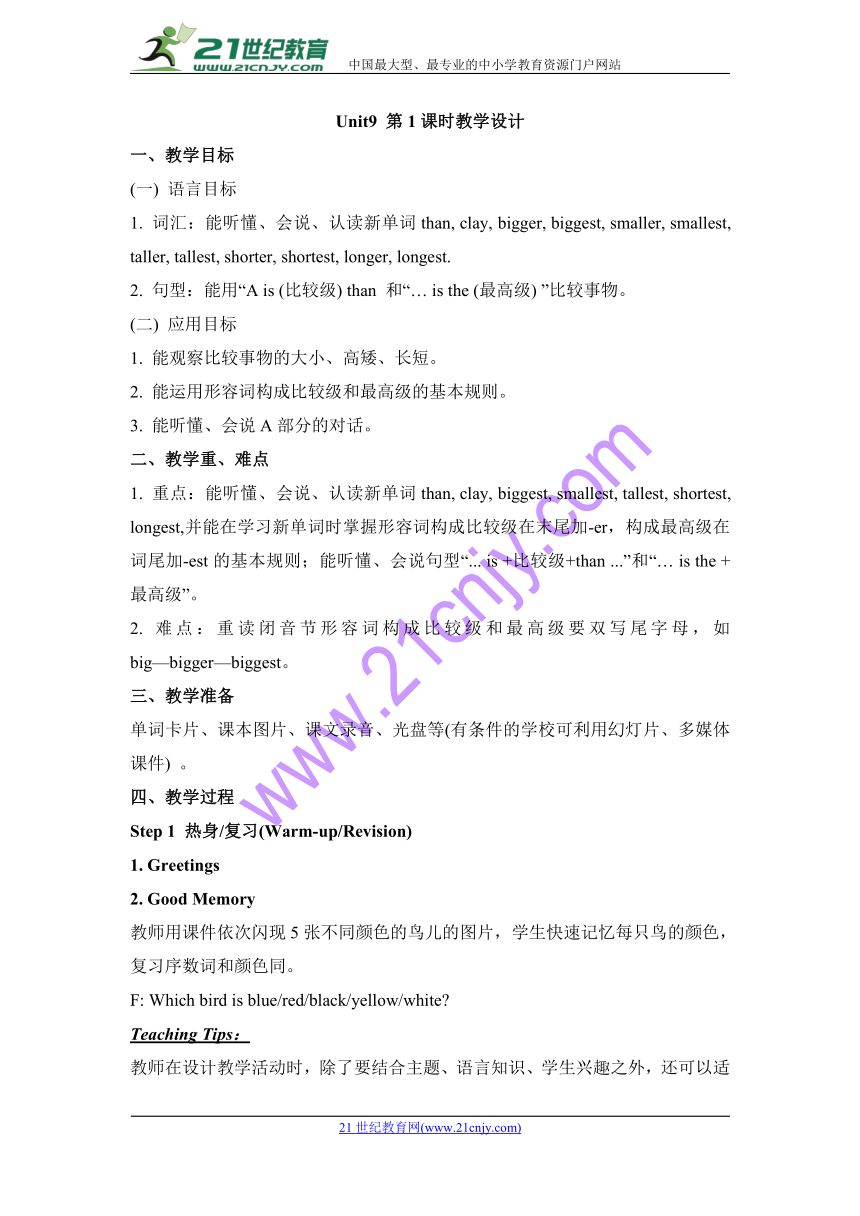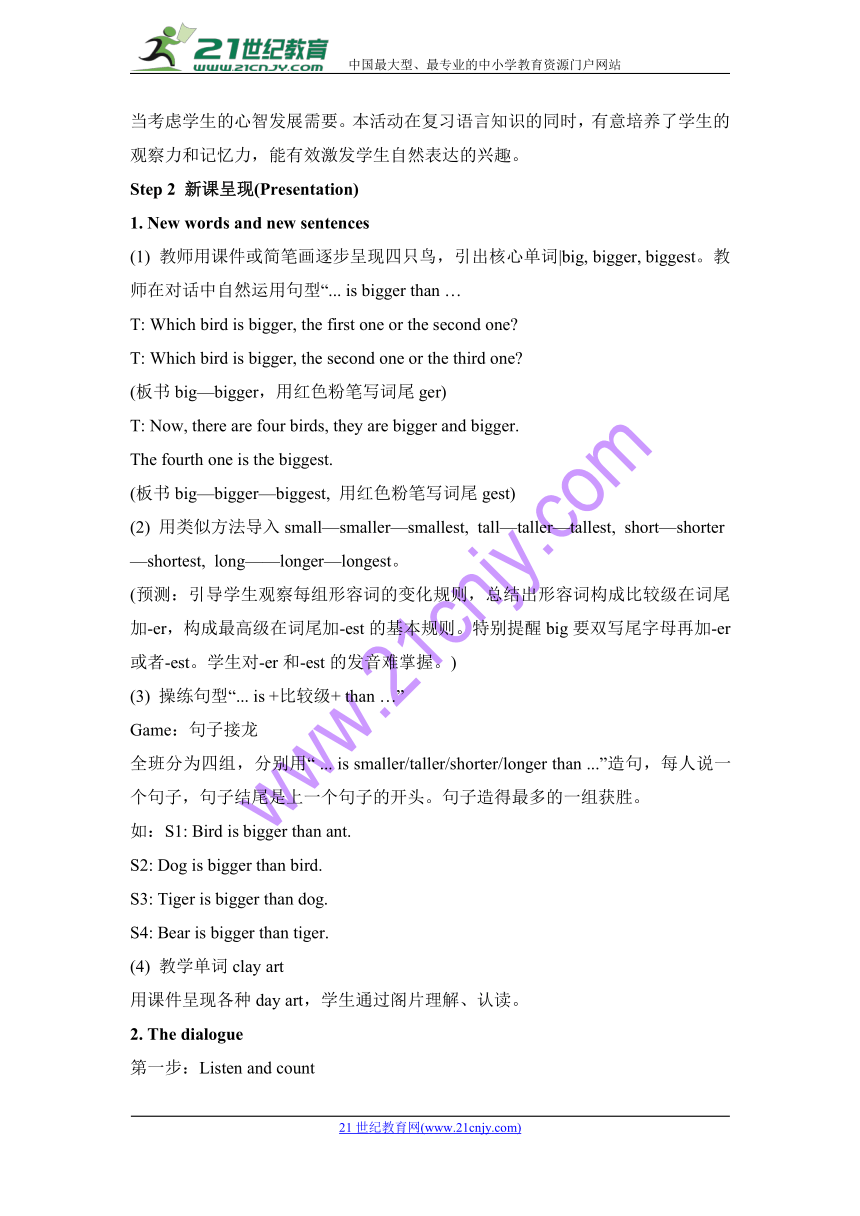Unit 9 This bird is bigger than fist one 第一课时教学设计
文档属性
| 名称 | Unit 9 This bird is bigger than fist one 第一课时教学设计 |  | |
| 格式 | zip | ||
| 文件大小 | 122.3KB | ||
| 资源类型 | 教案 | ||
| 版本资源 | 湘少版 | ||
| 科目 | 英语 | ||
| 更新时间 | 2018-06-12 20:17:48 | ||
图片预览


文档简介
Unit9 第1课时教学设计
一、教学目标
(一) 语言目标
1. 词汇:能听懂、会说、认读新单词than, clay, bigger, biggest, smaller, smallest, taller, tallest, shorter, shortest, longer, longest.21cnjy.com
2. 句型:能用“A is (比较级) than 和“… is the (最高级) ”比较事物。
(二) 应用目标
1. 能观察比较事物的大小、高矮、长短。
2. 能运用形容词构成比较级和最高级的基本规则。
3. 能听懂、会说A部分的对话。
二、教学重、难点
1. 重点:能听懂、会说、认读新单词than, clay, biggest, smallest, tallest, shortest, longest,并能在学习新单词时掌握形容词构成比较级在末尾加-er,构成最高级在词尾加-est的基本规则;能听懂、会说句型“... is +比较级+than ...”和“… is the +最高级”。2·1·c·n·j·y
2. 难点:重读闭音节形容词构成比较级和最高级要双写尾字母,如big—bigger—biggest。21·世纪*教育网
三、教学准备
单词卡片、课本图片、课文录音、光盘等(有条件的学校可利用幻灯片、多媒体课件) 。
四、教学过程
Step 1 热身/复习(Warm-up/Revision)
1. Greetings
2. Good Memory
教师用课件依次闪现5张不同颜色的鸟儿的图片,学生快速记忆每只鸟的颜色,复习序数词和颜色同。
F: Which bird is blue/red/black/yellow/white?
Teaching Tips:
教师在设计教学活动时,除了要结合主题、语言知识、学生兴趣之外,还可以适当考虑学生的心智发展需要。本活动在复习语言知识的同时,有意培养了学生的观察力和记忆力,能有效激发学生自然表达的兴趣。【21·世纪·教育·网】
Step 2 新课呈现(Presentation)
1. New words and new sentences
(1) 教师用课件或简笔画逐步呈现四只鸟,引出核心单词|big, bigger, biggest。教师在对话中自然运用句型“... is bigger than …www-2-1-cnjy-com
T: Which bird is bigger, the first one or the second one? 21·cn·jy·com
T: Which bird is bigger, the second one or the third one?2-1-c-n-j-y
(板书big—bigger,用红色粉笔写词尾ger)
T: Now, there are four birds, they are bigger and bigger.21*cnjy*com
The fourth one is the biggest.
(板书big—bigger—biggest, 用红色粉笔写词尾gest)
(2) 用类似方法导入small—smaller—smallest, tall—taller—tallest, short—shorter—shortest, long——longer—longest。www.21-cn-jy.com
(预测:引导学生观察每组形容词的变化规则,总结出形容词构成比较级在词尾加-er,构成最高级在词尾加-est的基本规则。特别提醒big要双写尾字母再加-er或者-est。学生对-er和-est的发音难掌握。) 【21cnj*y.co*m】
(3) 操练句型“... is +比较级+ than …”
Game:句子接龙
全班分为四组,分别用“ ... is smaller/taller/shorter/longer than ...”造句,每人说一个句子,句子结尾是上一个句子的开头。句子造得最多的一组获胜。
如:S1: Bird is bigger than ant.
S2: Dog is bigger than bird.
S3: Tiger is bigger than dog.
S4: Bear is bigger than tiger.
(4) 教学单词clay art
用课件呈现各种day art,学生通过阁片理解、认读。
2. The dialogue
第一步:Listen and count
不打开书,只听音,听音前,给出任务:
How many clay birds did he make?
第二步:Listen and fill in the blanks
不打开书,听第二遍,完整复述下列句子。
(1) The first bird is ______.
(2) The second bird is______ than the first one.
(3) The third bird is______ the second one.
(4) The fourth bird_______ the third one.
(5) The______ bird is the biggest.
第三步:Listen and check
打开书,再听一遍,检查自己刚才听得是否正确。
第四步:Listen and repeat
听音,跟读,引导学生正确模仿,提醒学生注意模仿语音语调。
第五步:Read and act
根据课本图片,引导学生记忆对话和表演。
Step 3 趣味操练(Practice)
1. Game:大搜查
教师宣布搜查令,如 big book, small eraser, tall boy, short hair, long ruler等,学生们查找自己的物品,与同学互相比较并说出“My ... is bigger/smaller/taller/shorter/longer than...”直到找出的物品是全班最大的/最小的/最高的/最短的/最长的为止。21世纪教育网
2. Game:开火车
教师准备好big, small, tall, short和long五张单词卡片,在黑板上写一个或者说一个数字N,再马上擦掉。请第一个学生从单词卡中袖出一张,大声读出单词,第二个同学马上说出相应的比较级,第三个及后面的学生重复比较级,直到第N个学生站起来,说出相应的最高级再抽一张单词进行下一轮游戏。该游戏可以分小组比赛,又快又正确的一组获胜。21教育网
Step 4 作业布置(Homework)
1. 听一听,背一背:听录音,背诵A部分课文。
2. 记一记:听写B部分单词。
一、教学目标
(一) 语言目标
1. 词汇:能听懂、会说、认读新单词than, clay, bigger, biggest, smaller, smallest, taller, tallest, shorter, shortest, longer, longest.21cnjy.com
2. 句型:能用“A is (比较级) than 和“… is the (最高级) ”比较事物。
(二) 应用目标
1. 能观察比较事物的大小、高矮、长短。
2. 能运用形容词构成比较级和最高级的基本规则。
3. 能听懂、会说A部分的对话。
二、教学重、难点
1. 重点:能听懂、会说、认读新单词than, clay, biggest, smallest, tallest, shortest, longest,并能在学习新单词时掌握形容词构成比较级在末尾加-er,构成最高级在词尾加-est的基本规则;能听懂、会说句型“... is +比较级+than ...”和“… is the +最高级”。2·1·c·n·j·y
2. 难点:重读闭音节形容词构成比较级和最高级要双写尾字母,如big—bigger—biggest。21·世纪*教育网
三、教学准备
单词卡片、课本图片、课文录音、光盘等(有条件的学校可利用幻灯片、多媒体课件) 。
四、教学过程
Step 1 热身/复习(Warm-up/Revision)
1. Greetings
2. Good Memory
教师用课件依次闪现5张不同颜色的鸟儿的图片,学生快速记忆每只鸟的颜色,复习序数词和颜色同。
F: Which bird is blue/red/black/yellow/white?
Teaching Tips:
教师在设计教学活动时,除了要结合主题、语言知识、学生兴趣之外,还可以适当考虑学生的心智发展需要。本活动在复习语言知识的同时,有意培养了学生的观察力和记忆力,能有效激发学生自然表达的兴趣。【21·世纪·教育·网】
Step 2 新课呈现(Presentation)
1. New words and new sentences
(1) 教师用课件或简笔画逐步呈现四只鸟,引出核心单词|big, bigger, biggest。教师在对话中自然运用句型“... is bigger than …www-2-1-cnjy-com
T: Which bird is bigger, the first one or the second one? 21·cn·jy·com
T: Which bird is bigger, the second one or the third one?2-1-c-n-j-y
(板书big—bigger,用红色粉笔写词尾ger)
T: Now, there are four birds, they are bigger and bigger.21*cnjy*com
The fourth one is the biggest.
(板书big—bigger—biggest, 用红色粉笔写词尾gest)
(2) 用类似方法导入small—smaller—smallest, tall—taller—tallest, short—shorter—shortest, long——longer—longest。www.21-cn-jy.com
(预测:引导学生观察每组形容词的变化规则,总结出形容词构成比较级在词尾加-er,构成最高级在词尾加-est的基本规则。特别提醒big要双写尾字母再加-er或者-est。学生对-er和-est的发音难掌握。) 【21cnj*y.co*m】
(3) 操练句型“... is +比较级+ than …”
Game:句子接龙
全班分为四组,分别用“ ... is smaller/taller/shorter/longer than ...”造句,每人说一个句子,句子结尾是上一个句子的开头。句子造得最多的一组获胜。
如:S1: Bird is bigger than ant.
S2: Dog is bigger than bird.
S3: Tiger is bigger than dog.
S4: Bear is bigger than tiger.
(4) 教学单词clay art
用课件呈现各种day art,学生通过阁片理解、认读。
2. The dialogue
第一步:Listen and count
不打开书,只听音,听音前,给出任务:
How many clay birds did he make?
第二步:Listen and fill in the blanks
不打开书,听第二遍,完整复述下列句子。
(1) The first bird is ______.
(2) The second bird is______ than the first one.
(3) The third bird is______ the second one.
(4) The fourth bird_______ the third one.
(5) The______ bird is the biggest.
第三步:Listen and check
打开书,再听一遍,检查自己刚才听得是否正确。
第四步:Listen and repeat
听音,跟读,引导学生正确模仿,提醒学生注意模仿语音语调。
第五步:Read and act
根据课本图片,引导学生记忆对话和表演。
Step 3 趣味操练(Practice)
1. Game:大搜查
教师宣布搜查令,如 big book, small eraser, tall boy, short hair, long ruler等,学生们查找自己的物品,与同学互相比较并说出“My ... is bigger/smaller/taller/shorter/longer than...”直到找出的物品是全班最大的/最小的/最高的/最短的/最长的为止。21世纪教育网
2. Game:开火车
教师准备好big, small, tall, short和long五张单词卡片,在黑板上写一个或者说一个数字N,再马上擦掉。请第一个学生从单词卡中袖出一张,大声读出单词,第二个同学马上说出相应的比较级,第三个及后面的学生重复比较级,直到第N个学生站起来,说出相应的最高级再抽一张单词进行下一轮游戏。该游戏可以分小组比赛,又快又正确的一组获胜。21教育网
Step 4 作业布置(Homework)
1. 听一听,背一背:听录音,背诵A部分课文。
2. 记一记:听写B部分单词。
同课章节目录
- Unit 1 What did you do during the holidays?
- Unit 2 Katie always gets up early.
- Unit 3 I like my compute
- Unit 4 The Mid-Autumn Festival is coming...
- Unit 5 It will be sunny and cool tomorrow
- Unit 6 I will bring a big bottle of orange juice
- Unit 7 What can I do?
- Unit 8 We shouldn't waste wate
- Unit 9 This bird is bigger than fist one...
- Unit 10 I don't feel well today
- Unit 11 Shall we go to the theatre?
- Unit12 It's Christmas again!
